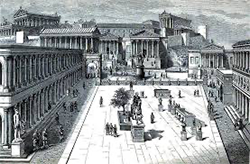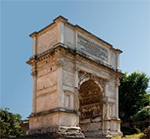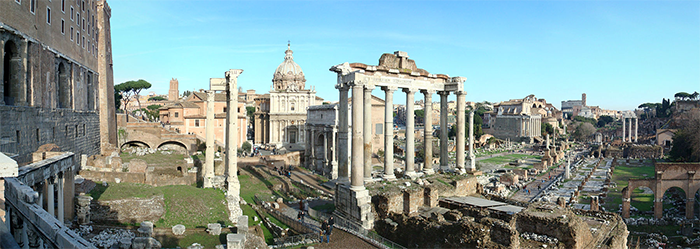The Roman Forum
The Forum was the heart of the city of Rome, the place where important activities took place in the realms of politics and religion. The Forum served as a setting for a market and other activities as well and was a natural meeting point because it had many of the city's most revered and majestic monuments. 
The Forum was a rectangular-shaped open area in the approximate valley between two of Rome's Seven Hills Rome, the Capitoline Hill and the Palatine Hill. One story had it that Rome's founder, Romulus designated the area as a safe site for meetings with a rival, Titus Tatius. Another story said that the Romans and Sabines fought on the site in the 8th Century B.C. One of the first buildings to be built there was the Regia, or Royal Palace, sometime in the 7th Century B.C. Enabling further construction was the construction of the Cloaca Maxima, the "Great Sewer," the capstone of a process that began with draining the marshland between the two hills. Historians think that the first gatherings in the Forum took place about 500 B.C., about the time of the founding of the Roman Republic. As the years went by, people used the Forum for many types of public events, such as public speeches, public meetings, religious ceremonies, elections, criminal trials, and even gladiator contests (before the appearance of the Colosseum. 
One very important and well-known building in the Forum area was the Curia, the Senate building. Nearby was the Rostra, a platform from which many a person gave a speech. Running through the Forum was the Sacra Via, the main road. Also in the Forum were the carcer ("prison") and the Tabularium ("records office"). One of the earliest temples to appear in the Forum was one dedicated to the god Saturn; it was built just a few years after the founding of the Republic. Other well-known temples in the Forum honored Castor and Pollux and Vesta; near the latter was the Atrium Vestae, the House of the Vestal Virgins. As the city grew and the number of buildings in the Forum grew as well, some leaders, like Augustus, increased its size. Other leaders, like Julius Caesar, had built a new forum nearby. A later emperor, Trajan, did the same. Augustus it was as well who ordered the Forum repaved, using marble. (The dictator Sulla had done something similar in 80 B.C. On the occasion of the reconstruction of the Temple of Concordia August, in A.D. 10, the Romans spruced up the Forum as well. 
Various emperors had built a number of triumphal arches in the Forum. The first was to celebrate the achievements of Fabius Maximus, proconsul in Transalpine Gaul, in 121 B.C. Other emperors honored with triumphal arches included Titus (left) and Septimius Severus. Also appearing in the Forum at various times were temples to deified emperors, including Vespasian and Antoninus Pius. Not to be outdone, Domitian had built a statue of himself riding a horse. A fire in 283 wrecked much of the Forum, and the Romans built a new Curia and a new colonnade. The emperor Constantine in 312 embarked on the last major expansion of the Forum, with the Basilicia of Maxentius. After that, the Forum went into decline, not least because the emperors moved the capital from Rome to Constantinople. Most of the Forum was destroyed when Alaric and the Visigoths sacked Rome in 410.  After the fall of Rome, the area fell into decline and cows called the Forum home.
|
|
Social Studies for Kids
copyright 2002–2025
David White




